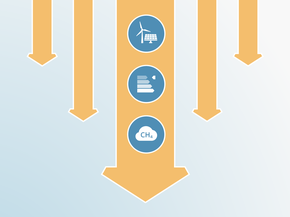Assumptions
Historical emissions
Historical emissions data excl. the LULUCF sector for all GHGs were obtained from the PRIMAP-hist national historical emissions time series and cover the period from 1990 to 2021 (Gütschow and Pflüger, 2023). This gas-by-gas breakdown by sector: energy, industrial process, agriculture, and waste. Historical emissions data for the LULUCF sector are based on the Chinese inventory as submitted to the UNFCCC for the years 1994, 2005, 2010, 2012 and 2014 and is not extrapolated onwards due to accounting uncertainties (Government of China, 2018).
We estimate 2022 emissions on a sector-by-sector approach. For energy and industry-related CO2 emissions, we apply a growth rated based on the average of estimates from Global Carbon Project (2022) and IEA (2023a) due to weaker growth and downticks in construction, industry and transport emissions stemming from China’s zero-COVID lockdown policies. Other sectors and gases follow the approaches in the next section.
As of September 2018, the CAT uses 100-year Global Warming Potentials (GWPs) from the IPCC Fourth Assessment Report (AR4).
Current policy projections
Energy-related CO2 emissions:
For our current policy projections (CPP), we start with the IEA World Energy Outlook 2022 (WEO 2022) Stated Policies Scenario (STEPS) —which for China we take as a basis for the current policies scenario as stated policies are highly certain to be achieved in the country— and calculate total primary energy demand (TPED) based on the Chinese methodology of applying the average efficiency of coal-fired power plants to calculate TPED from non-fossil sources (renewables and nuclear). We start with an efficiency of 305.5 grams coal equivalent (gce) per kWh (around 8.9 MJ/kWh for Chinese coal-fired power plants), based on NDRC (2021b), which improves over time to 300 gce/kWh in 2025 and 295 gce/kWh in 2030 based on a conservative scenario from IEA (2021c).
The scenario assumes that China meets a range of policy targets including:
- Cross-cutting policies:
- Electricity sector:
- Industry:
- Buildings:
- Transport:
As the scenario does not show sufficient resolution on China’s energy system in 2025, the CPP scenario is adjusted to meet the above 2025 policy targets in addition to the following:
- 39% non-fossil share in electricity generation for 2025 from the 14th FYP on energy (NDRC and NEA, 2022)
- 15% gas in primary energy supply in 2030 (8%) (Asia Pacific Energy, no date)
- 50% renewable energy capacity by 2025 (SASAC, 2021)
- 33% of total electricity generation from renewables (18% excluding hydro) (32%) (NDRC, 2022)
- 50% non-fossil share in electricity generation target by 2030 (Asia Pacific Energy, no date)
We also revise total primary energy demand (TPED) projections for 2025 upwards to around 6 billion tonnes of coal equivalent, in line with estimates from Chinese researchers assessing the 14th FYP on energy (NDRC and NEA, 2022). The gas share target from Energy Supply and Consumption Revolution Strategy (2016-2030) is revised down from 15% to 12% to align with China National Petroleum Corporation forecasts and extended to 2035, given the rapid displacement of coal is delayed in the wake of national energy security focus and growing coal consumption projections (Chow and Singh, 2021). Gas is assumed to replace coal 1:1, as coal-to-gas switching is seen to be primarily driven by industry and buildings sectors, rather than in the power sector (Cornot-Gandolphe, 2019).
Supply-side targets such as production capacity of fossil fuels and installed capacity targets from the 14th FYP on energy are not explicitly quantified as these policies will likely result in excess capacity with uncertain outcomes for emissions.
After integrating the aforementioned policies to the energy sector results, we calculate energy sector emissions using IEA (2022b) WEO STEPS emission factors for fossil fuels in both scenarios and account for developments in carbon, capture and storage (CCS) (after 2030).
Industrial-process emissions:
We project industrial-process CO2 emissions by applying growth rates from cement process emissions for the non-OECD region based on the IEA Energy Technology Perspectives 2016 report’s 6DS scenario to our latest 2021 value estimates. CO2 emissions for industry peak have been revised to peak in 2030 (previously 2025) according to China’s building materials peaking plan (MIIT of China, NDRC, MEE, et al., 2022).
Other non-CO2 emissions:
For non-CO2 emissions from energy, fugitive emissions, agriculture, industrial processes, and waste, we apply sector-specific growth rates for non-CO2 emissions from (Lin et al., 2019) to our latest 2021 value estimates. This source considers recent policies implemented since 2015, leading to improved certainty on Chinese non-CO2 emissions in 2030, compared to previous assessments. The reference scenario used assumes that no non-CO2 mitigation measures will be implemented before 2050, except for efforts made to reach the Montreal Protocol targets for HFCs from HCFC-22 production, which are phased out. We additionally quantify the impacts of the Kigali Amendment on HFCs following the staged phaseout schedule eventually leading to an 80% reduction from baseline levels by 2045.
The CAT has dropped a range (an alternative CPP scenario) for its 2023 assessment.
NDC and other targets
For China’s updated NDC targets, we quantify the non-fossil target, the peaking target, the carbon intensity target, and renewable energy capacity target separately. For the quantification of all targets, we also incorporate achievement of the demand-side policies in China’s current policies pathway (CPP).
The elements of China’s targets that we quantify apply to CO2 only (excl. LULUCF), given the scope of the targets. To calculate total GHG emissions (excl. LULUCF), we add non-CO2 emissions based on our current policies projections as described below.
Peaking Target:
Since the NDC contains the target of peaking CO2 emissions before 2030, the implications for what an “NDC scenario” constitutes can be interpreted in a variety of ways—for instance, the least ambitious way would be to assume emissions simply peak by 2030 while a more ambitious interpretation would be to assume that this peaking happens earlier at an arbitrary date. According to our current policy projections, China’s emissions are due to peak around 2025. Thus, the quantification of the peaking target is equivalent to the peak emissions level in our CPP, which peaks around 2025 (before 2030).
Non-Fossil Target:
China’s NDC non-fossil target has been increased to 25% in 2030 in its updated NDC while China’s 14th FYP includes the now intermediary target of 20% by 2025. In our CPP, China is projected to overachieve these targets comfortably.
To calculate energy-related CO2 emissions based on the 2030 target, we:
- Recalculate the total primary energy demand (TPED) from IEA WEO (2022b) STEPS
- Align TPED to the CPP scenarios. Technology shares for non-fossil sources are decreased to achieve the 25% share target (no more, no less), while coal and gas are assumed to replace the gap from decreased non-fossil sources
- Adjust individual non-fossil energy sources equally based on their relative share of non-fossil energy demand in the CPP
Renewable Capacity Target:
The NDC includes a target of 1,200 GW of wind and solar installed by 2030. In our CPP, China is projected to overachieve this target comfortably for both technologies. To quantify emission levels under this target, solar and wind capacity is revised downward to 1,200 GW in total according to their respective ratio expected in 2030. Under this target achievement, we only expect approximately 460 GW of wind power and 740 GW of solar PV installed in China. Like the quantification of the non-fossil share target, other elements are assumed to be the same as the CPP. For example, other supply technologies are expected to supply the same amount of power. Overall primary energy demand in the country is also assumed to be the same as the CPP. We assume that the difference in energy supplied (less wind and solar) is supplied by coal and gas. Given that fossil fuel capacity is not replaced by wind and solar one-for-one, overall power capacity in China’s energy system decreases with the achievement of this target.
Carbon Intensity Targets:
For the calculation of the intensity targets for 2020 and 2030, we use historical emissions data from China’s most recent inventory submission to the UNFCCC and historical GDP data from China’s Statistical Yearbook up to 2018 (National Bureau of Statistics of China, 2018). For historical years after 2018, we deviate from official Chinese data due to annual inconsistencies; we now apply latest official growth rates from the Chinese government (rather than absolute numbers), validated by international organisations such as the World Bank and IMF, to establish data until the latest historical year. GDP projections until 2030 are mainly based off IMF (2023) until 2028 and supplemented with near-term forecasts (thus establishing an optimistic and pessimistic range for growth). From 2026 to 2030, we use the underlying GDP forecast from WEO STEPS 2021 (IEA, 2021d). We assume that the carbon intensity target applies to all CO2 emissions excluding LULUCF. The emissions quantification for carbon intensity targets changes annually, due to updated forecasts in China’s GDP trajectory.
| Energy-related NDC targets | Overview of Key Assumptions |
|---|---|
| Non-Fossil Target: |
• Share of non-fossil energy in TPED reaches 25% in 2030 but does not exceed the benchmark. • Non-fossil demand to reach this target depends on all non-fossil technologies equally. The weight of individual non-fossil energy technologies within non-fossil energy share are assumed to be equivalent as the CPP, but the non-fossil share of TPED differs. I.e. If nuclear makes up 10% of non-fossil energy in the CPP, it will also make up 10% of total non-fossil energy share (revised to 25% in the target scenario). • Non-fossil energy target is assumed to exclude traditional biomass given it emits emissions when combusted and makes up minimal demand in the Chinese energy system. • Since the NDC target is less ambitious than the CPP, all demand for non-fossil energy will be smaller in the target scenario. • Differences in the share of non-fossil energy in the target scenario and CPP is assumed to be displaced or replaced with coal; share of other fossil technologies stay equivalent. |
| Peaking Target: |
• No specific year is assumed to peak “before 2030” given the vague nature of the target. Thus, we interpret this target as following the CPP projections, with carbon dioxide peaking in 2030. • According to our CPP projections, carbon dioxide peaks around 2025. |
| Renewable Capacity Target: |
• Total GW installed for solar and wind technologies, per specified in the target, are set (lowered) to a total of 1,200 GW in 2030. • The 1,200 GW for wind and solar is distributed across the two technologies according to their comparative shares projected in the CPP. Both technologies retain the same capacity factors in the target scenario as in the CPP, meaning they are assumed to generate an equivalent ratio of electricity per GW installed as in the CPP. • Total electricity and energy generated to satisfy demand is equivalent to the CPP. • Differences in energy demand from renewables in the target scenario and CPP is assumed to be displaced or replaced with coal; energy demand from other technologies are assumed to stay equivalent |
A note on the global aggregation:
China’s rating is based on the two NDC emissions targets (which are estimated to have the lowest emission levels): the lower end of the peaking target in 2030, which is equivalent to the emissions trajectory under China’s current policies, and the carbon intensity target. We employ this method as we try to capture the likely range of China’s emissions levels when achieving their NDC, but there is uncertainty on absolute emission levels as China has several targets: China’s peaking target is guaranteed to be achieved by definition, but which of China’s remaining NDC targets is achieved (or if they all are) is uncertain.
We exclude the most pessimistic interpretations—target with the highest expected emissions—as we would be assuming they emit more than the CPP analysis shows. We also do not take only the most optimistic interpretation—lower bound of China’s carbon intensity target— as this is not constrained target (fluctuating year to year depending on economic forecasts). If we only took one target, we would then be assuming China’s other quantitative targets arecompletely null. The emission levels of all of China’s targets are dependent on future developments (e.g., growth in energy consumption, GDP). We thus take a median approach to capture the middle range (median) of the two most stringent targets to be conservative: the minimum of the carbon intensity target and the next most ambitious target, the peaking target.
In previous years, the non-fossil share target resulted in lower emissions than the carbon intensity target; due to increased outlook in energy demand and lower outlook on growth, achievement of the carbon intensity target would now result in lower emissions.
Mid-Century Long-Term Low Greenhouse Gas Emission Development Strategy
The officially-submitted LTS appears to confirm the commitment covers only carbon dioxide emissions. Due to the 2060 timeframe extending past our scope of analysis, as well as insufficient details in intermediary targets to reaching the carbon neutrality target, we take a simplified linear approach for China’s pathway to carbon neutrality.
Emissions until 2030 are established through our current policy projections. For CO2, we assume a linear decarbonisation to zero in 2060 from 2030 levels. For non-CO2, we assume a more conservative phaseout path to zero in 2080 from 2030 levels. Although the government is seemingly pursuing expansion of China’s carbon sinks in the LULUCF sector, they do not provide modelling details on the level of its sinks in 2060. Thus, we assume constant LULUCF sinks until 2060 of approximately -780 MtCO2e based off a 10-year historical average from its latest inventory year (until further details are made available), which is consistent with modelled forestry carbon sinks from He et al (2021)’s 2°C and 1.5°C scenarios. China’s resulting emissions in 2060 (excl. LULUCF) is then assumed to be the addition of CO2 (offset with LULUCF sinks) and leftover non-CO2 GHGs. The pathway for all GHG emissions from 2030 to the emissions in 2060 is linearly interpolated.
COVID-19 impact
As we now use baseline data that already captures impacts from COVID-19, we apply no further methods to estimate COVID-19 related changes in greenhouse gas emissions for China until 2030.
Global Warming Potentials
The CAT uses Global Warming Potential (GWP) values from the IPCC's Fourth Assessment Report (AR4) for all its figures and time series. Assessments completed before December 2018 (COP24) used GWP values from the Second Assessment Report (SAR).
Further analysis
Latest publications
Stay informed
Subscribe to our newsletter




